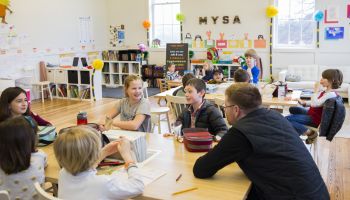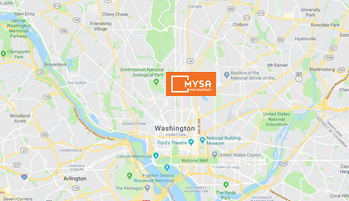
Nov 19 Experiential Education at Mysa
Last Friday, Mysa students caught the J2 bus from our Bethesda campus to the bus stop on East West Highway and Meadowbrook Lane. We crossed traffic and entered the a trail following Rock Creek past neighborhoods and a horse stable to a local park. The mission was to use tools that students had on their person — their five senses and their problem solving skills — to make observations about the health of the creek and the impact the surrounding area had on the environment. After many days of rain, the creek had recently been out of bank, and students picked their way delicately through the mud to sketch pictures of plant life and count pieces of trash.
It’s not always immediately apparent when and if a student is “learning” in an out-of-classroom environment. Engagement is much easier to detect, particularly in students who would otherwise prefer to be on their phone or computer. Laughter, physical movements, and a certain breathy, rapid exchange of words are always evidence of entertainment. But, in order to convince teachers, administrators, parents, and even students themselves that outdoor and experiential education is essential to growth and development — particularly in middle and high school kids, when outdoor time is traditionally limited — one must find evidence of actual, academic learning. Spending the day in Rock Creek Park identifying animal prints in the mud is certainly a memorable lesson on tributary watersheds, but how much value can a lesson have in teaching science?
The National Association of Colleges and Employers (NACE) has identified a set of transferable skills that are lacking in recent college graduates who are entering the workforce. These competencies are thought to broadly prepare young employees for a transition into any career and are often valued more than content knowledge in a specific field. Included are skills such as critical thinking/problem solving, written and oral communication, leadership, and teamwork. In a traditional classroom environment, where subject areas are siloed and test scores determine the course, there is limited time for these transferable skills. However, in the outdoor or experiential realm, the possibilities are endless.
Mysa students are presented with real challenges in these situations. Younger students ask themselves, “How can I measure distance from the edge of the water to a raccoon print if I don’t have a ruler or yardstick?” The higher level students are tackling issues that are more complex and often abstract. How can we rally a community to make daily choices that will improve the health of the creek? How can we entice the horse stable to set requirements for nitrogen rich horse manure disposal systems? Students brainstorm writing letters to the local officials, presenting their scientific findings at community association meetings, and networking with nonprofits for community engagement support. In this one day lesson, students are mastering science standards, math standards, and english language arts standards, but, more importantly, they are learning transferable skills. By experiencing and engaging with their environment they are learning to adapt, to problem solve, to work as a team.
By Ariel Martinez Brumbaugh – ELA and Lead Teacher for Mysa 6-12th grade






